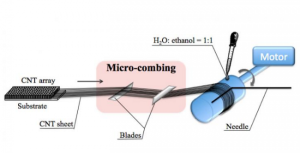
While CNT alignment is still not perfect, it will now be able to be scaled up for large-scale production.
Source: North Carolina State University
A new process called “microcombing” has been developed to created ultra-strong and highly conductive carbon nanotubes (CNTs).
The films produced from the microcombing technique could have practical applications in improving electronics and aerospace technology.
“It’s a simple process and can create a lightweight CNT film, or ‘bucky paper,’ that is a meter wide and twice as strong as previous such films—it’s even stronger than CNT fibers,” said Yuntian Zhu, Distinguished Professor of Material Science and Engineering at NC State.
The researchers began by growing the CNTs in a way that caused them to ribbon, which they then attached to a spool to allow them to neatly wind up.
This from HNGN:
As the spool pulls, the ribbon is dragged between a pair of fissured surgical blades that create microscopic fissures on their cutting surface. The fissured create a “microcomb” that aligns the CNTs in a similar fashion to a comb being pulled through tangled hair. As the aligned CNTs are being wound onto the spool, an alcohol solution is applied to pull them even closer together to form a super strong bond. The CNT ribbon is layered on top of itself as the spool winds it up, creating the pure CNT film.
The results from this new technique yield twice the strength and an 80 percent higher electrical conductivity than an uncombed CNT film.
Want to learn more about carbon nanotubes? Head over the the Digital Library to check out the papers in the field!

